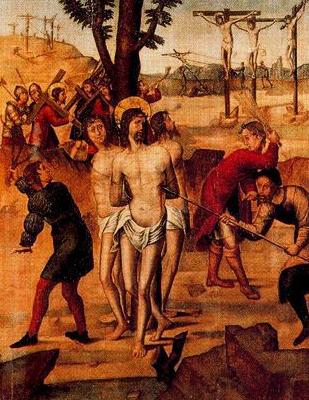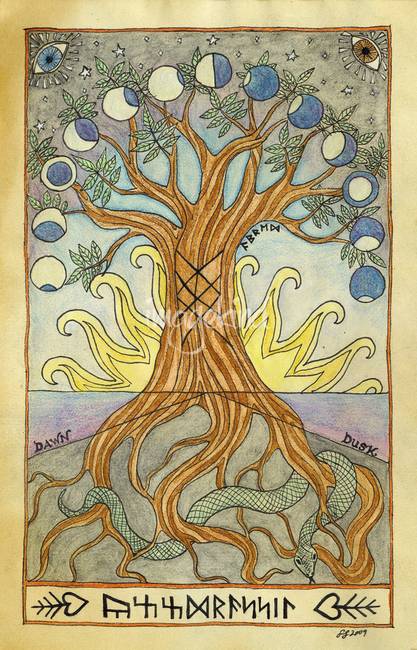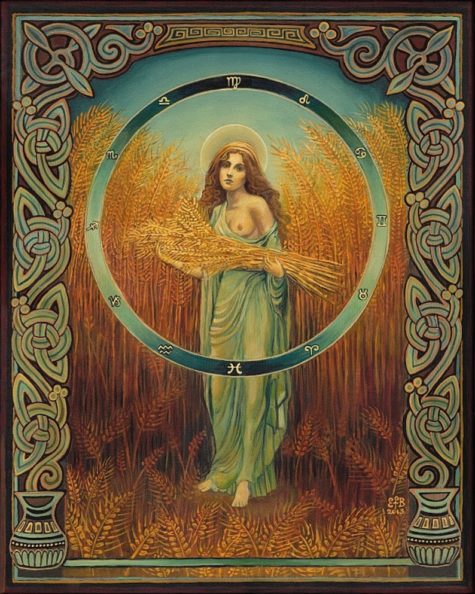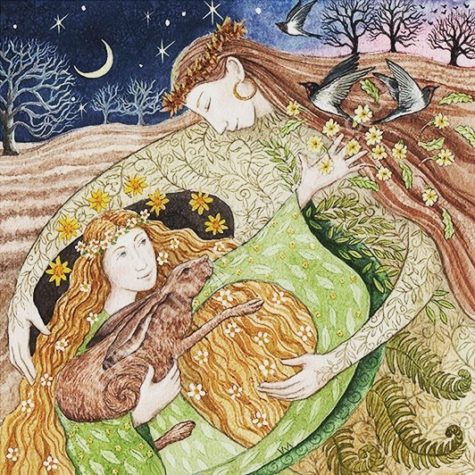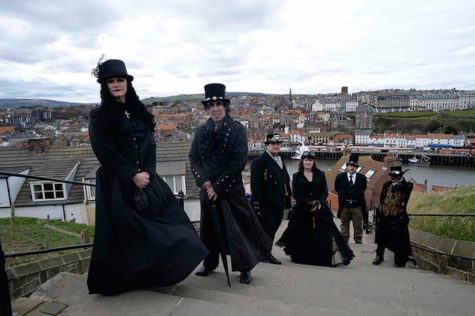Yearly Archives: 2019
Traditional weather lore has it that St. Dunstan was a great brewer who sold himself to the devil on the condition that the devil would blight the apple trees to stop the production of cider, Dunstan’s rival drink. This is said to be the cause of the wintry blast that usually comes about this time. (May 19)
Foggier yet, and colder! Piercing, searching, biting cold. If the good Saint Dunstan had but nipped the Evil Spirit’s nose with a touch of such weather as that, instead of using his familiar weapons, then, indeed, he would have roared to lusty purpose.
~A Christmas Carol
This piece of folklore seeks to explain the late May frosts, known as ‘Franklin Days’ in the West Country, which often hit between 17-19 or 19-21 May. The tale was apparently particularly popular in Devon in the 19th and 20th centuries and goes thus:
Dunstan had bought some barley and made some beer, which he then hoped to sell for a good price. Seeing this the Devil appeared before him and offered to blight the local apple trees with frost (the tale is presumably set in Somerset, perhaps when Dunstan is Abbot of Glastonbury). This would ensure there was no cider and so drive demand for beer. Dunstan accepted the offer but stipulated that the frost should strike from the 17-19 May.
Stories About St. Dustan and the Devil:
According to legend, St. Dunstan had a number of encounters with the devil. The most famous story, which entered popular folklore, tells how he pulled the devil by the nose with his blacksmith’s tongs.
The story goes that while he was living as a hermit in a cell at Glastonbury, he occupied himself with various crafts, including metalwork. Against the old church of St Mary he built a small cell five feet long and two and a half feet deep. It was there that Dunstan studied, worked at his handicrafts, and played on his harp. It is at this time, according to a late 11th-century legend, that the Devil is said to have tempted Dunstan.
One day, as evening was coming on, an old man appeared at his window and asked him to make a chalice for him. Setting aside what he was working on, Dunstan agreed to the request and set to work. But as he was working his visitor began to change shape: one moment he was an old man, then a young boy, then a seductive woman.
Dunstan realized that his guest was the devil; but, pretending not to notice, he went on with his task. He took up the tongs from among his tools and laid them in the fire, waiting until they were red-hot. Then, pulling them out of the fire, he turned round and seized the devil by the nose with the tongs. The devil struggled and screamed, but Dunstan held on until at last he felt he had triumphed. Then he threw the devil out of his cell and it fled, running down the street and crying “Woe is me! What has that bald devil done to me? Look at me, a poor wretch, look how he has tortured me!”
St Dunstan stood in his ivied Tower,
Alembic, crucible, all were there;
When in came Nick to play him a trick,
In guise of a damsel passing fair.
Every one knows
How the story goes:
He took up the tongs and caught hold of his nose.
~Lay of St Dunstan, 1840
Many people heard and saw this, and the following day they came to Dunstan and asked him what had happened. He said to them, “These are the tricks of devils, who try to trap us with their snares whenever they can. But if we remain firm in the service of Christ, we can easily defeat them with his help, and they will flee from us in confusion.” And from that time he dwelt safely in his little cell.
The story was of course retold in other forms, as here in playful fashion in the South English Legendary:
þe deuel he hente bi þe nose & wel faste drou;
He twengde & ssok hure bi þe nose þat þe fur out blaste.
þe deuel wrickede here & þere & he huld euere faste,
He 3al & hupte & drou a3en & made grislich bere.
He nolde for al is bi3ete þat he hadde icome þere!
Wiþ is tonge he strok is nose & twengde him euere sore,
Forte it was wiþinne ni3te þat he ne mi3te iseo namore.
þe ssrewe was glad & bliþe inou þo he was out of is honde
And flei & gradde bi þe lift þat me hurde into al þe londe:
“Out, wat haþ þis calwe ido? wat haþ þis calwe ido?”
In þe contreie me hurde wide hou þe ssrewe gradde so.
As god þe ssrewe hadde ibeo habbe ysnut atom is nose,
He ne hi3ede namore þuderward to tilie him of þe pose.
He seized the devil by the nose and pulled very hard; he tweaked and shook him by the nose so that fire burst out. The devil wriggled here and there, and he still held fast. He yelled and hopped and pulled away and made a horrible commotion. He wished for all the world that he’d never come there! With his tongs Dunstan yanked at his nose and nipped him very sore, until night came on and he could no longer see. The villain was glad and happy indeed that he was out of his hands, and fled and cried out so it was heard all over the land: “Alas, what’s this bald one done? What’s this bald one done?” It was heard far around how the wicked one cried out. The villain had got such a good tweaking of his nose, he never hurried back there again to heal his cold!
On another occasion, when Dunstan was praying alone, the devil appeared to him in the likeness of a wolf with a gaping mouth, snarling and baring his teeth. Dunstan would not be distracted from concentration on his prayers, so the devil suddenly changed himself into a little fox, trying to get Dunstan’s attention by jumping about, contorting himself and trying to get Dunstan to laugh at him.
But, smiling a little, Dunstan only said, “You are revealing how you usually behave: by your tricks you flatter the unwary so that you can devour them. Now get out of here, wretch, since Christ, who crushed the lion and the dragon with his heel, will overcome you by his grace through me, whether you’re a wolf or a fox.”
Another legend regarding the Devil and St. Dunstan also occurred in Mayfield when the convent there had just been built. The Devil appeared to St. Dunstan and said that he was going to knock down all the houses in the village. St. Dunstan bargained with the Devil and got him to agree to leave standing any house with a horseshoe on the outside. At that time, the custom of nailing horseshoes to doors for luck wasn’t well known so the Devil agreed but St. Dunstan managed to nail a horseshoe to all the houses in the village before the Devil could get to them so the village was saved.
The Devil managed to get some measure of revenge against St. Dunstan by repeatedly setting Mayfield church, then built of wood, off its normal East-West axis, leaving St. Dunstan to repeatedly correct it. According to the lore, this was accoplished by pushing the church back into the proper east-west alignment with his shoulder!
Another church is involved with yet another St. Dunstan story. This time it is the steeple of the church in the village of Brookland, just over the border into Kent. The Devil took the steeple and was chased by St. Dunstan who caused the Devil to drop the steeple near Hastings by application of the tongs mentioned in the Mayfield story.
According to one version of the story, the injured devil flew off from Mayfield to cool his nose in the springs of Tunbridge Wells, and that’s how its famous waters got their reddish tint (don’t let anyone tell you it’s because of the iron in the water). Alternatively, he flew away with the tongs still attached to his nose, and they dropped off in the place near Brighton which is now called Tongdean (for, I hope, obvious reasons).
About Saint Dustan:
- Feastday: May 19
- Patron of armorers, goldsmiths, locksmiths, and jewelers
Born of a noble family at Baltonsborough, near Glastonbury, England, Dunstan was educated there by Irish monks and while still a youth, was sent to the court of King Athelstan. He became a Benedictine monk about 934 and was ordained by his uncle, St. Alphege, Bishop of Winchester, about 939.
After a time as a hermit at Glastonbury, Dunstan was recalled to the royal court by King Edmund, who appointed him abbot of Glastonbury Abbey in 943. He developed the Abbey into a great center of learning while revitalizing other monasteries in the area. He became advisor to King Edred on his accession to the throne when Edmund was murdered, and began a far-reaching reform of all the monasteries in Edred’s realm.
Dunstan also became deeply involved in secular politics and incurred the enmity of the West Saxon nobles for denouncing their immorality and for urging peace with the Danes. When Edwy succeeded his uncle Edred as king in 955, he became Dunstan’s bitter enemy for the Abbot’s strong censure of his scandalous lifestyle. Edwy confiscated his property and banished him from his kingdom.
Dunstan went to Ghent in Flanders but soon returned when a rebellion replaced Edwy with his brother Edgar, who appointed Dunstan Bishop of Worcester and London in 957. When Edwy died in 959, the civil strife ended and the country was reunited under Edgar, who appointed Dunstan Archbishop of Canterbury. The king and archbishop then planned a thorough reform of Church and state.
Dunstan was appointed legate by Pope John XII, and with St. Ethelwold and St. Oswald, restored ecclesiastical discipline, rebuilt many of the monasteries destroyed by the Danish invaders, replaced inept secular priests with monks, and enforced the widespread reforms they put into effect. Dunstan served as Edgar’s chief advisor for sixteen years and did not hesitate to reprimand him when he thought it deserved.
When Edgar died, Dunstan helped elect Edward the martyr king and then his half brother Ethelred, when Edward died soon after his election. Under Ethelred, Dunstan’s influence began to wane and he retired from politics to Canterbury to teach at the Cathedral school and died there. Dunstan has been called the reviver of monasticism in England. He was a noted musician, played the harp, composed several hymns, notably Kyrie Rex splendens, was a skilled metal worker, and illuminated manuscripts.
Sources:
In Italian popular culture, Friday the 17th (and not the 13th) is considered a day of bad luck. In fact, in Italy, 13 is generally considered a lucky number. However, due to Anglo-Saxon influence, young people consider Friday the 13th unlucky as well.
Here are some simple ways to change your luck:
- Spread candies and coins around your house, especially in the corners of rooms.
- Wear coral, wash it with Holy Water and/or Coconut water (the liquid from a coconut) to replenish it’s powers.
- Bathe in Laurel leaves.
- Make a small mojo with equal portions of Pine Needles, Lavender, Laurel ,Geranium Leaves, Patchouli and keep under your pillow.
- Keep a small package of Alfalfa in a cupboard to bring good luck to the home.
- Place dried seaweed under the busiest portion of the house to draw luck and prosperity to you.
- To change your luck, add one tablespoon of nutmeg to six cups of boiling water. Steep for three hours. Use for body anointing or add to a ritual bath.
Collected from various sources
The feast day of St Agathius is May the 7th, (formerly May 8th). It is unclear why the date was changed, and some information online still has it listed as May the 8th. He is a patron saint of soldiers, and most often invoked against headaches.
- About him:
Saint Agathius (Greek: Ακακιος; died 303), also known as Achatius or Agathonas or Acacius of Byzantium, according to Christian tradition, was a Cappadocian Greek centurion of the imperial army, martyred around 304.
Agathius was arrested on charges for being a Christian by Tribune Firmus in Perinthus, Thrace, tortured and then brought to Byzantium where he was scourged and beheaded, being made a martyr because he would not renounce his Christian faith. The date of his martyrdom is traditionally May 8, when his feast is observed.
- Note:
St. Acacius the Centurion is not to be confused with the St. Acacius who was crucified in the second century along with 10,000 (!) companions. Neither of these martyrs is the St. Achatius numbered among the “14 Holy Helpers.”
- For Headaches:
I’ve found that amethyst is one of the best gemstones to help relieve headaches and reduce stress and tension. You can simply sit quietly and hold a piece of amethyst against your forehead, or you could make a gem elixir so that you can take a drop or two of the liquid when necessary.
Another traditional spell is to find a pebble and hold it against your head and say: ‘Pain from my head go into this stone, go into this stone, go into this stone. Pain from my head go into this stone, go into this stone and stay there.’ Then take the stone outside and hurl it away from you with as much force as you can manage.
Sources:
According to astrological and lunar lore, there are best days for doing a variety of tasks. The best days listed here are based on both the phase of the moon and its position in the zodiac. Many people believe that if you do the tasks on the dates listed, you will get the best results possible.
May 1:
- Cut Hair (to slow growth)
- Demolition
- Harvest
- Kill Plant Pests
- Mow Grass (to slow growth)
- Pick Apples and Pears
- Quit Smoking
- Start Diet (to lose weight)
- Wash Wooden Floors
May 2:
- Cut Hair (to slow growth)
- Demolition
- Harvest
- Kill Plant Pests
- Mow Grass (to slow growth)
- Pick Apples and Pears
- Quit Smoking
- Start Diet (to lose weight)
- Wash Wooden Floors
May 3:
- Advertise Something for Sale
- Ask For a Loan
- Dig Post Holes
- Get Married
- Make Jams and Jellies
- Mow Grass (to slow growth)
- Paint
- Plant Root Crops
- Transplant (seedlings and plants)
May 4:
- Advertise Something for Sale
- Buy a Home
- Cut Firewood
- Cut Hair (to increase growth)
- Dig Holes
- Get Married
- Mow Grass (to increase growth)
- Paint
- Plant Above Ground Crops
- Wax Floors
May 5:
- Cut Firewood
- Dig Holes
- Kill Plant Pests
- Mow Grass (to increase growth)
- Travel (for pleasure)
May 6:
- Cut Firewood
- Dig Holes
- Kill Plant Pests
- Mow Grass (to increase growth)
- Travel (for pleasure)
May 7:
- Cut Firewood
- Dig Holes
- Kill Plant Pests
- Mow Grass (to increase growth)
- Travel (for pleasure)
May 8:
- Bake
- Buy a Home
- Cut Firewood
- Cut Hair (to increase growth)
- Dig Holes
- Get Married
- Mow Grass (to increase growth)
- Plant Above Ground Crops
- Plant Flowers
- Plant Seed Beds
- Start Diet (to gain weight)
- Wax Floors
May 9:
- Bake
- Buy a Home
- Cut Firewood
- Cut Hair (to increase growth)
- Dig Holes
- Get Married
- Mow Grass (to increase growth)
- Plant Above Ground Crops
- Plant Flowers
- Plant Seed Beds
- Start Diet (to gain weight)
- Wax Floors
May 10:
- Buy a Home
- Cut Firewood
- Dig Holes
- Get Married
- Kill Plant Pests
- Mow Grass (to increase growth)
- Paint
- Travel (for pleasure)
May 11:
- Cut Firewood
- Dig Holes
- Get Married :
- Kill Plant Pests
- Mow Grass (to increase growth)
- Paint
- Travel (for pleasure)
May 12:
- Cut Firewood
- Dig Holes
- Kill Plant Pests
- Mow Grass (to increase growth)
- Wax Floors
May 13:
- Cut Firewood
- Dig Holes
- Kill Plant Pests
- Mow Grass (to increase growth)
- Wax Floors
May 14:
- Bake
- Cut Firewood
- Dig Holes
- Get Married
- Mow Grass (to increase growth)
- Plant Above Ground Crops
- Plant Flowers
- Wax Floors
May 15:
- Bake
- Cut Firewood
- Dig Holes
- Get Married
- Mow Grass (to increase growth)
- Plant Above Ground Crops
- Plant Flowers
- Set Eggs
- Wax Floors
May 16:
- Cut Firewood
- Cut Hair (to increase growth)
- Dig Holes
- Mow Grass (to increase growth)
- Plant Above Ground Crops
- Plant Seed Beds
- Set Eggs
- Wax Floors
May 17:
- Cut Firewood
- Cut Hair (to increase growth)
- Dig Holes
- Mow Grass (to increase growth)
- Plant Above Ground Crops
- Plant Seed Beds
- Wax Floors
May 18:
- Advertise Something for Sale
- Castrate Farm Animals
- Cut Hair (to slow growth)
- Demolition
- Dry Fruits and Vegetables
- Kill Plant Pests
- Mow Grass (to slow growth)
- Pick Apples and Pears
- Potty Train a Child
- Quit Smoking
- Slaughter
- Start Diet (to lose weight)
- Wash Windows
- Wash Wooden Floors
- Wean a Baby or an Animal
May 19:
- Advertise Something for Sale
- Castrate Farm Animals
- Cut Hair (to slow growth)
- Demolition
- Dry Fruits and Vegetables
- Kill Plant Pests
- Mow Grass (to slow growth)
- Pick Apples and Pears
- Potty Train a Child
- Quit Smoking
- Slaughter
- Start Diet (to lose weight)
- Wash Windows
- Wash Wooden Floors
- Wean a Baby or an Animal
May 20:
- Advertise Something for Sale
- Castrate Farm Animals
- Cut Hair (to slow growth)
- Demolition
- Dry Fruits and Vegetables
- Kill Plant Pests
- Mow Grass (to slow growth)
- Pick Apples and Pears
- Potty Train a Child
- Quit Smoking
- Slaughter
- Start Diet (to lose weight)
- Wash Windows
- Wash Wooden Floors
- Wean a Baby or an Animal
May 21:
- Castrate Farm Animals
- Mow Grass (to slow growth)
- Plant Root Crops
- Potty Train a Child
- Prune Trees
- Wean a Baby or an Animal
May 22:
- Castrate Farm Animals
- Mow Grass (to slow growth)
- Plant Root Crops
- Potty Train a Child
- Prune Trees
- Wean a Baby or an Animal
May 23:
- Castrate Farm Animals
- Cut Hair (to slow growth)
- Dig Post Holes
- Kill Plant Pests
- Make Jams and Jellies
- Mow Grass (to slow growth)
- Paint
- Potty Train a Child
- Quit Smoking
- Start Diet (to lose weight)
- Wash Wooden Floors
- Wean a Baby or an Animal
May 24:
- Castrate Farm Animals
- Cut Hair (to slow growth)
- Dig Post Holes
- Kill Plant Pests
- Make Jams and Jellies
- Mow Grass (to slow growth)
- Paint
- Potty Train a Child
- Quit Smoking
- Set Eggs
- Start Diet (to lose weight)
- Wash Wooden Floors
- Wean a Baby or an Animal
May 25:
- Castrate Farm Animals
- Cut Hair (to slow growth)
- Dig Post Holes
- Kill Plant Pests
- Make Jams and Jellies
- Mow Grass (to slow growth)
- Paint
- Potty Train a Child
- Quit Smoking
- Set Eggs
- Start Diet (to lose weight)
- Wash Wooden Floors
- Wean a Baby or an Animal
May 26:
- Brew
- Can Fruits and Vegetables
- Castrate Farm Animals
- Get Married
- Mow Grass (to slow growth)
- Plant Root Crops
- Potty Train a Child
- Transplant (seedlings and plants)
- Wean a Baby or an Animal
May 27:
- Brew
- Can Fruits and Vegetables
- Castrate Farm Animals
- Get Married
- Mow Grass (to slow growth)
- Plant Root Crops
- Potty Train a Child
- Transplant (seedlings and plants)
- Wean a Baby or an Animal
May 28:
- Cut Hair (to slow growth)
- Demolition
- Harvest
- Kill Plant Pests
- Mow Grass (to slow growth)
- Pick Apples and Pears
- Quit Smoking
- Start Diet (to lose weight)
- Wash Wooden Floors
May 29:
- Cut Hair (to slow growth)
- Demolition
- Harvest
- Kill Plant Pests
- Mow Grass (to slow growth)
- Pick Apples and Pears
- Quit Smoking
- Start Diet (to lose weight)
- Wash Wooden Floors
May 30:
- Cut Hair (to slow growth)
- Demolition
- Harvest
- Kill Plant Pests
- Mow Grass (to slow growth)
- Pick Apples and Pears
- Quit Smoking
- Start Diet (to lose weight)
- Wash Wooden Floors
May 31:
- Advertise Something for Sale
- Ask For a Loan
- Dig Post Holes
- Get Married
- Make Jams and Jellies
- Mow Grass (to slow growth)
- Paint
- Plant Root Crops
- Transplant (seedlings and plants)
Source: The Farmer’s Almanac
Yggdrasil Day is celebrated either on April 22 or on the last Friday in April. It is not an old Northern tradition nor an ancient pagan celebration, it is a fairly new holiday in the Neopagan tradition and an alternative to Arbor Day.
This day is a time to contemplate the place of humankind within the nine worlds, and to celebrate the blessings of nature, often shown by planting a tree. This is also a time to celebrate one’s culture, heritage, and spirituality.
Regardless of faith, Yggdrasil Day is a great opportunity for anyone to give back to nature and recognize our inter-dependency on both one another and the natural world.
Arbor Day is all about trees, and their importance here on our tiny blue world. I am not sure how many trees are planted on this day worldwide, maybe millions, but none can compare to the greatest tree that was ever planted, Yggdrasil. Arbor Day is another one of those secular celebration days that I have borrowed, and use to honor something, or someone, in our great pantheon of Gods and Goddesses.
Today for me is Yggdrasil Day. A day to honor our Great World Ash for all that it does and means to us Midgardians. If you consider it to be an actual tree, or just some cosmic force that holds the nine worlds together is a matter for a later discussion. Either way it is to us, who follow the Old Ways, the great tree of life that binds our nine world cosmology together as one cohesive structure.
Let us not forget also that we here on Midgard have another very strong connection to trees in our lore. I quote from Voluspa,
“Until three of the Aesir assembled there, strong and benevolent, came to the sea. They found on the shore two feeble trees, Ask and Embla, with no fixed fate.”
Gylfaginning finishes the story:
“And they picked these up and created men from them. The first gave them spirit and life, the second understanding and power of movement, the third, form, speech, hearing and sight. They gave them clothes and names.”
The Gods gave life to the trees, and mankind was therefore born. Voluspa gives us a wonderful description of the Great Ash Tree:
“There is an ash tree, its name is Yggdrasil. A tall tree watered from a cloudy well. Dew falls from its boughs down into the valleys. Ever green it stands beside the Norn’ s spring.”
The importance and sacredness to the Gods is shown in Gylfaginning when Gangleri asks : ” Where is the chief place, or sanctuary of the Gods? ” High One replies: ” It is by the ash tree Yggdrasil. There every day the Gods hold court. ”
The High One then goes on to give the best description of Yggdrasil.
“The Ash is the best and greatest of all trees, its branches spread out over the whole world and reach up over heaven. The tree is held in place by three mighty roots that spread far out. One is among the Aesir; the second among the Frost Ogres, where once was Ginnungagap; the third extends over Niflheim, and under that root is the well Hvergelmir. But Nidhogg gnaws at the root from below. Under the root that turns in the direction of the Frost Ogres lies the Spring of Mimir, in which is hidden wisdom and understanding. The third root of the ash tree is in the sky, and under that root is the very sacred spring called Urd. There the Gods hold their court of justice.”
The High One adds later on:
“There is a great deal to tell about it . In its branches sits an eagle, and it is very knowledgeable. Between its eyes sits a hawk called Vedrfolnir. A squirrel named Ratatosk springs up and down the Ash and conveys words of abuse between the great eagle and Nidhogg. Four harts leap about the branches of the Ash and eat the shoots. And along with Nidhogg there are so many serpents that no tongue can count them.”
Yggdrasil is the cosmic World tree, and Ash tree, that binds this world to the others, to the world of the gods, of the spirits and ancestors, it is the symbol of our union with nature. In Nordic mythology, it was an ash tree known as Yggdrasil, the cosmic tree that symbolizes the center of the world, that Odin hung for nine days and nine nights in trance, received the sacred knowledge of runes, the Elder Futhark.
Yggdrasil has always played an important role in the lives of the Northern people of Europe. We have all came from nature and we will all return to it one day, so at this day we honor the forces of nature and we will always remember how important is to protect the world we live in.
Trees are the lungs of our world just has it is Yggdrasil in the Nordic cosmology, it is the shelter that gives us peace and protection, it is the spiritual path of the Gods and of our ancestors, the way which leads to the other worlds. And so as nature gives us these gifts, in turn we must honor it, and because a gift calls for a gift, in turn we must give to nature our protection, our care and our respect. In this day you should plant a tree, you should become the protector of those who have given you shelter, fight against the evils that are corrupting our natural world.
Celebrating Yggdrasil Day:
I honor the Great World Ash Yggdrasil every year on Arbor Day, the last Friday in April, with a full ritual, and by placing a new Valknut, Thor’s Hammer, or rune stone necklace on the branches of my artificial 6 ft. white ash tree that I have sitting next to Odin’s altar in my living room. I think it is very appropriate that the Great Ash sits next to the All – Father’s altar because of his many connections to Yggdrasil. I do not celebrate Christmas so to me this wonderful 6 ft. ash tree, with all its shining jewelry hanging in the branches, evokes the same emotions of joy and wonder that I used to experience as a child on Christmas morning.
The best thing is I get to experience it 365 days a year because I never take down the tree. It honors me with its presence, and I honor it with my presents, day after day, year after year. I found the 6 ft. ash at Amazon. com for about $ 300.00. It was definitely worth the money !
This year I am going to present the Great Ash with a very special gift that I found at the Scandinavian Festival last year. It is a beautifully carved Thor’s hammer. This white Thor’s hammer is hand carved out of bone, and has beads on either side of the Hammer. It looks kind of tribal ! It will make a beautiful addition to the dozen or so necklaces already hanging in its holy branches.
Coming just a week after Jord’s Day, ( Earth Day ), it is fitting to have a day to honor Yggdrasil, and to re- seed the earth with seedling trees. Planting trees is not only a great way to honor Mother Jord, and Yggdrasil, but it is also a wonderful gift for future generations of mankind. I cannot imagine a world without trees, and there would be no nine world universe without Yggdrasil the Great Nine World Ash!
More about the Ash Tree
The Ash tree – Fraxinus Excelsior is also known as guardian tree in all of Europe. With the exception of the Mediterranean region, this tree can live till three hundred years. Its leaves appear after its flowers and this strange detail led this tree to be know as the “Venus of the woods”. Its roots penetrate deeply into the ground causing difficulty to other kinds of vegetation to grow in there. Due to the hardness of its wood, it has been widely used for the manufacture of lances and tool handles. Thus it is possible that the name of this tree in English, derives from the Anglo-Saxon word Asec, which means “Ritual Spear.”
Celtic Druids once used the wood of these trees, to make their rods and staffs.
Traditionally the yule log (At the winter solstice) is of ash tree, this is because it is one of the few woods that can burn immediately, even though it is still green, and offers an excellent and long-lasting illumination.
The Icelandic word Aske, which has similarities with Ash, means “fire with large flame.” This tree is also sacred to the gods Thor and Odin.
Sources:
Go Fly A Kite Day
“Go fly a kite” is an idiom that is used as a way of telling someone to go away or to leave you alone. The phrase originated in the 1940s and was very popular at that time and for the next few decades. Its meaning is derived from its literal meaning: a person would probably need to go away to actually fly a kite. A similar phrase is “Go jump in a lake.” In these phrases, the important word is “go,” not the place where the person is directed to go. Another idiom with a similar meaning is “Get lost.”
Go Fly a Kite Day is observed next on Sunday, April 21st, 2019. It has always been observed the third Sunday in April.
Source: Checkiday
The main theme for January is “CLEAN IT UP”.
We have some very big energies coming in that you will not be able to take advantage of if you are bogged down in physical, emotional and energetic clutter, old intentions, unfinished business, anything you have put off or procrastinated and should have done “yesterday”, regrets, unexpressed communication, attachments to disappointments and unmanifested dreams, persisting bad habits, and we can go on and on as the list is very long.
You cannot bring in the new without making space by cleaning out the old. It is very simple. We spend lots of time making new lists and talking about what we want to accomplish in 2019 but there is no room for anything new unless we declutter the past. If you clean up the past, you will have many more options about what and how to bring in some new dreams and experiences. And we have tremendous opportunity to do so.
Here is an image. You have an old roof that has been fixed and layered with new material many, many times. Now it is time for a new roof again as this one does not serve you. It is cracked and leaking. You can patch or put on another layer of roofing making the roof very heavy and requiring you to use the same material. Or you can completely remove the existing roof and start over giving you many options of what materials to use. Although it will take more time and energy up front, it will be something better and much improved and certainly much lighter.
The container of your life is like your roof. You can either layer it with the same old beliefs, judgments, intentions and habits, or you clean up the clutter and start over. Cleaning up requires courage to let go, to complete and to tie up loose ends. It may require you to release some old hopes and dreams. We need to recapitulate our sentimentality and make sure it is not getting in the way of creating something new. There are many layers and aspects of cleaning up and each of us will have different percentages of each one to do.
The year starts off with a set of eclipses potentiating any focused work we do this month. There is a pressurized quality to the month that motivates us to clean under the rug and dig deep to see what we actually have, what we want to keep, and what we need to clean up. You can find yourself busy these days with the inspiration to get that new roof on but it is important to do this in a structured and organized way. Otherwise the chaos (yes, it follows us into 2019) will have you distracted and focused in unimportant areas.
Physical Clean Up
This one is easy as it is very clear where the clutter is. Look with fresh eyes at what you surround yourself with and have the courage to get rid of things even if they are “still useful” but you have not actually used them in a long time. Be generous in passing them along to someone who may actually use them.
Papers, files, old photos, stuff your kids made, things people have given you, clothing equipment, electronics etc. If they do not have an active place in your life today, release them. Another category is unfinished projects that may have seemed like a good idea at one time but ask yourself if you are really going to ever get back and finish them. The attachment to all of these physical things is usually of the ego as they represent something connected to our identity; a success, relationship, time in our life, experience or event, recognition, education etc.
The artisan role of the year is a master of destruction. Use this artisan talent wisely in dismantling your current container so you can recreate it to serve you better. Take one aspect or section at a time and drawer by drawer, you will gain momentum in your process of clean up. There will be many parts you will keep, but they will end up being organized differently. To support this, you can start by making some changes in your schedule to accommodate the clean-up process.
Emotional Clean Up
This is an area that is usually somewhat messy as it has to do mostly with relationships, karma, betrayal, unrequited love, what was said, what wasn’t said, and lots of unfinished business and loose end especially around endings. Emotional confusion falls into this category as well. This includes not trusting your intuition or sitting on the fence about something and either not going after what you feel is right or not cutting something loose that looks right but isn’t, because you are too cautious to take the leap.
Feelings can be confusing especially when it comes to karmic agreements around relationships. When do you known when something is finished? And how do you know when something is right? The truth is, if it does not feel right or good, it probably isn’t and it is time to change the relationship. Sometimes, relationships need to simply change and not be banned forever. This is a great opportunity to clean up old relationships, even if just from your end, as well as to complete necessary communication. If someone has passed on before you got to say what you wanted to say, you can always write a letter to them and then burn it as an offering to clean the emotional energy.
Forgiveness is a big part of the emotional clean up and goes a long way to neutralize what has been charged with negative emotions. Practice forgiveness when possible especially with yourself as most judgment ends up being focused back inward in some way. It is time to release the attachment we have to suffering and low self-esteem. It will not get us through the pearly gates. Bottom line is that anything that has an emotional charge to it can use some clean up.
Energetic Clean Up
What are you still carrying for others? Where are your energy leaks?
The energetic clean up includes your belief systems and what you take on from others and how you allow the attention points and judgments of others to affect you energetically. This is often a subtle area to recognize but one that can profoundly affect you. Sometimes we do not know why we feel the way we do and what we feel makes no sense. This is probably due to an energy field that is cluttered with what is not yours.
This is an excellent month to learn how to differentiate between what is yours and what is not, and to set good boundaries.
On the other hand, when you hold your boundaries too close out of fear of losing control of your energy field, you are also not available for the power you could receive from all the greater sources of energy that support us, such as the elements, your essence, the energy of love, beauty, inspiration, wisdom, powerful times like the eclipses and moon cycles. Your allies, guides and spirit helpers and the ones that can connect you to those greater sources of energy. Cleaning up your energy and eliminating fear will open up communication and make room for these sources of greater power and energy.
National Look Up At The Sky Day is celebrated annually on April 14 (some calendars have it listed as April 12). On this day we all hope for good weather and look to the skies to reflect on the beauty above us.
There are many things that you can see as you sit back, relax and look up. The sky’s beautiful blue color, the clouds and their many shapes, the sun (maybe peeking through the clouds), and many different birds flying around. If it is nighttime, you may find the sky filled with stars and a beautiful moon.
It’s a busy time of the year. Spring is arriving, people are upping their workout regimes in order to get ready for summer, the newness of the new year has worn off and we are all buckling in, and in the US it’s tax season. This is a perfect day to stop and look up at the sky. Take a moment and enjoy your surroundings and just breathe.
The creators of this holiday remain anonymous, but their goal is very clear: to encourage people to take a little time to slow down and appreciate the little things in life. People who spent a lot of their time looking at the sky include Nicholas Copernicus, who proved the earth revolved around the Sun (and not the other way around as previously thought) Albert Einstein, the creator of the Theory of Relativity, and Leonardo da Vinci, who envisioned the first flying machines, so rest assured you will be in the best of company!
How to Celebrate Look Up at the Sky Day
As the name of this little holiday itself suggests, take some time to look up at the sky! We sometimes take natural beauty for granted, and only pay attention to the sky if, say, it happens to be raining and we want to complain. So take a blanket out to the park and just lay down on it and gaze upwards for a while—you’re likely to be amazed at how it changes depending on wind and other factors.
Watching birds go abut their lives as if nothing of importance was going on down below at all will likely be relaxing, and watching planes soaring high above you may even motivate you to take a trip to some faraway land. Look Up at the Sky Day was created to motivate us to see the world from a different perspective than we usually do and appreciate the beauty of nature, so make sure you get out and celebrate and make your life just a little bit more meaningful!
Sources:
Today (April 12) is the first day of the Ludi Cereales, another spring vegetation festival, this one in honor of the goddess Ceres, goddess of grains and cereal crops. It lasts for eight days, and like the Megalesia before it, the Cerealia culminates on its final day.
During Roman times, one of the symbolic rituals of the final day was the release of foxes into the Circus with flaming brands attached to their tails despite the fact that Ceres is notoriously a peaceful goddess and most often accepts offerings of spelt cakes and salt, as well as incense.
In the countryside, people offer milk, honey, and wine on the Cerealia (particularly the final day), after bearing them thrice around the fields.
More About This Festival
Ceres is the Goddess of agriculture, and was credited with the discovery of spelt wheat, the yoking of oxen and ploughing, the sowing, protection and nourishing of the young seed, and the gift of agriculture to humankind; before this, it was said, man had subsisted on acorns, and wandered without settlement or laws. She was the first to “break open the earth”, and all activities of the agricultural cycle were protected by her laws. She held the power to fertilize, multiply and fructify plant and animal seed, whose offspring were the physical incarnations of her power.
Her first plough-furrow opened the earth (Tellus’ realm) to the world of men and created the first field and its boundary; she thus determined the course of settled, lawful, civilized life. She mediated between plebeian and patrician factions. She oversaw the transition of women from girlhood to womanhood, from unmarried to married life and motherhood and the growth of children from infancy. Despite her chthonic connections to Tellus, she was not, according to Spaeth, an underworld deity. Rather, she maintained the boundaries between the realms of the living and the dead.
Given the appropriate rites, she would help the deceased into afterlife as an underworld shade (Di Manes): otherwise, the spirit of the deceased might remain among the living as a wandering, vengeful ghost.
The goddess was worshiped in many ways. There was the porca praecidanea, which involved sacrificing a fertile female pig and was necessary before a harvest. Cato indicates that sacrifices of any large food item will do, however, and suggests a pumpkin as an acceptable substitute for a pig, since it can be cut open and the seeds offered to Ceres in much the same way the entrails of the pig would be. After the offering of the porca praecidanea, it was customary to also give the goddess a libation of wine.
The poor could offer wheat, flowers, and a libation. The expectations of afterlife for initiates in the sacra Cereris may have been somewhat different, as they were offered “a method of living” and of “dying with better hope”.
Ceres’ major festival was the Cerealia – the ludi cereales, culminating on April 19 to celebrate the growth of grain and other agricultural products. Its original form is unknown; it may have been founded during the regal era. During the Republican era, it was organised by the plebeian aediles, and included ludi circenses (circus games). These opened with a horse race in the Circus Maximus, whose starting point lay just below the Aventine Temple of Ceres, Liber and Libera. In a nighttime ritual after the race, blazing torches were tied to the tails of live foxes, who were released into the Circus. The origin and purpose of this ritual are unknown; it may have been intended to cleanse the growing crops and protect them from disease and vermin, or to add warmth and vitality to their growth
Religiously, the purpose of the races and the games were to make the goddess favorably disposed toward the Roman people, so that she would give them a good harvest.
Visual depictions of Ceres were largely derived from Greek portrayals of Demeter. On two coin types, a bust of Ceres was pictured on one side, while a yoke of oxen was on the other. On other coins, she wears a crown of grain stalks called a corona spicea, holds stalks of wheat, and is occasionally pictured with wheat and barley grains. One coin actually portrayed her wearing a modius, an instrument used to measure grain, on her head. Another pictures a bust of series on one side, and a pair of seated male figures with a wheat stalk to their side on the other. The seated men represent the official distribution of grain to the people. Annona, the goddess who personified the wheat supply, appears alongside Ceres on several coins from the imperial period. Reliefs from the Augustan period have even gone so far as to depict her as a plant growing out of the ground. In one her bust emerges from the earth, holding bunches of poppies and grain in her upraised hands while two snakes twine about her arms.
Ceres also assimilated the visual symbols of the Eleusinian Mysteries, which most Romans observed in her name. Ceres is depicted with symbols of the Mysteries, such as riding in a chariot drawn by snakes while holding a torch in her right hand.
Persephone’s Return ~ A Ritual For The Cerelea
Most often celebrated on the last day of the Ludi Cereales (or April 19).
- Color: Green
- Element: Earth
- Offering: Flowers. Begin something new.
- Daily Meal: Dark, coarse bread. Root vegetables. Poppy seeds. Millet. Nuts and seeds.
Altar: Upon a green cloth set as many spring flowers as possible, a bowl of earth saved from the day of Persephone’s descent, and the figure of a girl’s head emerging from the earth.
Invocation to Persephone’s Return
Let the Earth take joy!
Demeter’s heart is warmed,
For her beloved daughter,
The maiden of Spring,
Has returned to the upper world!
Let all upon the Earth take joy!
Flowers spring from her footsteps,
Grass spreads between her toes,
The promise of the summer wind
Falls like butterflies newly loosed
From her hair the color of poppies and clay.
Let us all take joy!
She who descended in the autumn,
She who is married to Death
And yet arises in the bringing of Life,
She who has passed the bodies
Of a thousand corpses,
She who has sung with the shades
Of a thousand ancestors,
She rises to greet the morning sun
For as long as it is her time.
Then, like all things, she will descend again,
Into the depths of the Earth,
And we, we shall learn to love that cycle
Of rising and falling, of birth and death,
And truly call it a blessing.
Chant:
Kore Kore Kore Proserpina
Let one chosen for the work of the daily ritual carry the bowl of earth from person to person about the hall, and let each one take a bit of the earth and rub it on their faces, and let it remain until the evening ablutions.
~Info collected from various sources, including the Pagan Book of Hours
Whitby Goth Weekend is an alternative music festival held in Whitby. The event consists of two nights of live bands at the town’s largest venue, The Spa Pavilion, and three days of alternative trade stalls at the Spa Pavilion, Whitby Leisure Centre, and Whitby Brunswick Centre.
Dates for 2019 are as follows:
- 12-14 April
- 25-27 October
The festival was held yearly until 1997, when it became twice-yearly in April and October. It has grown into one of the world’s most popular goth music events attracting around 1,500+ attendees from across the UK and beyond. The term “Whitby Goth Weekend” is sometimes used as a generic term to describe events during the week in Whitby as a whole, although the name of the event and its associated logo are registered trademarks of Jo Hampshire of Top Mum Promotions.
The main event is held in the town’s largest venue Whitby Spa Pavilion (known as the Spa) and the Bizarre Bazaar ‘Goth Market’ is also held there and at Whitby Leisure Centre and the Brunswick Centre. Access to the Spa in the evening requires a ticket and live bands play on both Friday and Saturday from 08:00 until about midnight.
The “weekend” starts during the day on Friday and fringe events are held on Thursday, Sunday and Monday including club nights, markets, and a charity football match between visiting goth team Real Gothic, and local team Stokoemotiv Whitby.
During the October/November event there is an independent custom car show, ‘Whitby Kustom’ in the grounds of West Cliff School. There are also several “meet ups” aimed at goths with a particular interest, e.g. Lolita Goth.
Newbies who have not attended the event before are referred to as “Whitby Virgins”. To help introduce them to the event, there was a WGW Virgins Meet Up on the Friday morning at the Spa until about 2014.
In the mid-2000s the October weekend on or near Halloween began to attract large numbers of non-goths in Halloween, horror, historical, fantasy and sci-fi costume, which has led to an increase in photographers and visitors. The weekend now attracts other alternative subcultures, including Victorian vampires, rockers, punks and members of the steampunk subgenre.
Some regulars consider it no longer a purely “Goth” weekend, and it was acknowledged by Hampshire in the 2014 Whitby Goth Weekend Guide that in order to survive the event would have to diversify into other areas that have influenced Goth.
Concerns have grown about disrespect being shown to the graves in St. Mary’s Churchyard by photographers using them for photographic purposes which has resulted in a petition to have the area closed during the event, an action that Whitby Goth Weekend fully supports. The Bram Stoker Film Festival, which also took place in the town, rehashed a proposal to build a film set graveyard which photographers would be charged to use.
Sources:






